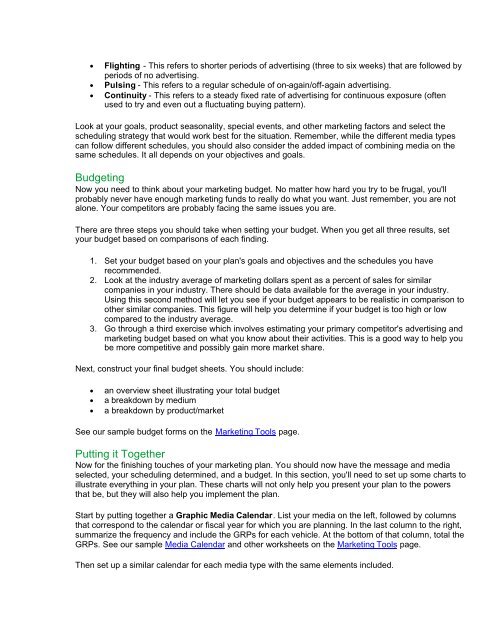The Marketing Plan Outline - Economic Development and ...
The Marketing Plan Outline - Economic Development and ...
The Marketing Plan Outline - Economic Development and ...
Create successful ePaper yourself
Turn your PDF publications into a flip-book with our unique Google optimized e-Paper software.
• Flighting - This refers to shorter periods of advertising (three to six weeks) that are followed by<br />
periods of no advertising.<br />
• Pulsing - This refers to a regular schedule of on-again/off-again advertising.<br />
• Continuity - This refers to a steady fixed rate of advertising for continuous exposure (often<br />
used to try <strong>and</strong> even out a fluctuating buying pattern).<br />
Look at your goals, product seasonality, special events, <strong>and</strong> other marketing factors <strong>and</strong> select the<br />
scheduling strategy that would work best for the situation. Remember, while the different media types<br />
can follow different schedules, you should also consider the added impact of combining media on the<br />
same schedules. It all depends on your objectives <strong>and</strong> goals.<br />
Budgeting<br />
Now you need to think about your marketing budget. No matter how hard you try to be frugal, you'll<br />
probably never have enough marketing funds to really do what you want. Just remember, you are not<br />
alone. Your competitors are probably facing the same issues you are.<br />
<strong>The</strong>re are three steps you should take when setting your budget. When you get all three results, set<br />
your budget based on comparisons of each finding.<br />
1. Set your budget based on your plan's goals <strong>and</strong> objectives <strong>and</strong> the schedules you have<br />
recommended.<br />
2. Look at the industry average of marketing dollars spent as a percent of sales for similar<br />
companies in your industry. <strong>The</strong>re should be data available for the average in your industry.<br />
Using this second method will let you see if your budget appears to be realistic in comparison to<br />
other similar companies. This figure will help you determine if your budget is too high or low<br />
compared to the industry average.<br />
3. Go through a third exercise which involves estimating your primary competitor's advertising <strong>and</strong><br />
marketing budget based on what you know about their activities. This is a good way to help you<br />
be more competitive <strong>and</strong> possibly gain more market share.<br />
Next, construct your final budget sheets. You should include:<br />
• an overview sheet illustrating your total budget<br />
• a breakdown by medium<br />
• a breakdown by product/market<br />
See our sample budget forms on the <strong>Marketing</strong> Tools page.<br />
Putting it Together<br />
Now for the finishing touches of your marketing plan. You should now have the message <strong>and</strong> media<br />
selected, your scheduling determined, <strong>and</strong> a budget. In this section, you'll need to set up some charts to<br />
illustrate everything in your plan. <strong>The</strong>se charts will not only help you present your plan to the powers<br />
that be, but they will also help you implement the plan.<br />
Start by putting together a Graphic Media Calendar. List your media on the left, followed by columns<br />
that correspond to the calendar or fiscal year for which you are planning. In the last column to the right,<br />
summarize the frequency <strong>and</strong> include the GRPs for each vehicle. At the bottom of that column, total the<br />
GRPs. See our sample Media Calendar <strong>and</strong> other worksheets on the <strong>Marketing</strong> Tools page.<br />
<strong>The</strong>n set up a similar calendar for each media type with the same elements included.













